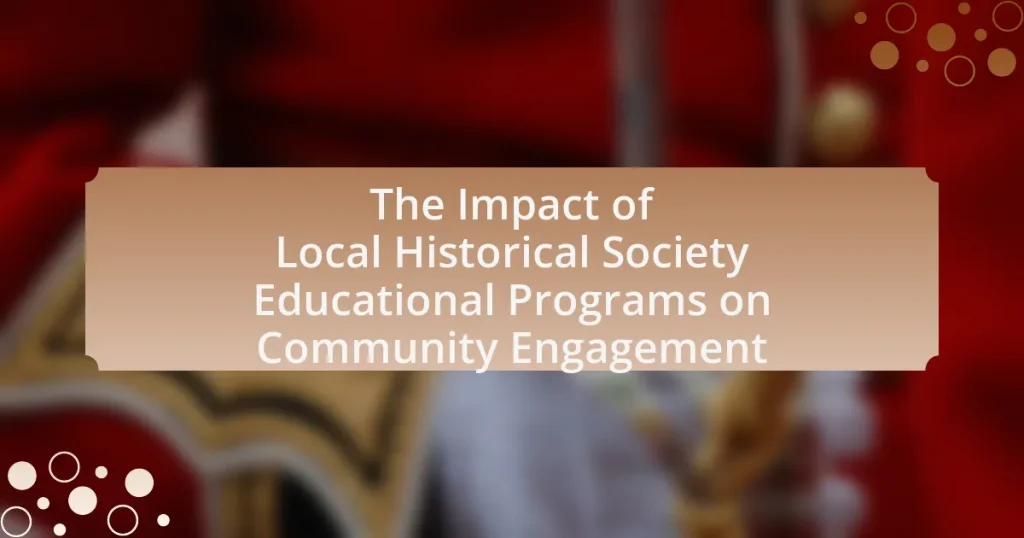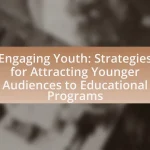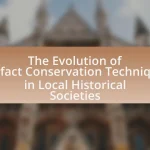Local Historical Society Educational Programs are initiatives aimed at educating communities about their local history, culture, and heritage through workshops, lectures, guided tours, and interactive activities. These programs enhance community engagement by fostering a sense of identity and belonging, leading to increased participation in local events and volunteer opportunities. The article explores the various types of educational programs offered, the primary participants involved, and the importance of these initiatives in strengthening community ties. Additionally, it addresses the challenges faced by historical societies, the role of technology, and best practices for effective program implementation, highlighting the measurable impacts on community engagement.
What are Local Historical Society Educational Programs?
Local Historical Society Educational Programs are initiatives designed to educate the community about local history, culture, and heritage. These programs often include workshops, lectures, guided tours, and interactive activities that engage participants of all ages. For example, many local historical societies offer school programs that align with educational standards, providing students with hands-on experiences related to their community’s history. Research indicates that such programs enhance community engagement by fostering a sense of identity and belonging among residents, as evidenced by increased participation in local events and volunteer opportunities.
How do these programs function within the community?
Local historical society educational programs function within the community by fostering engagement through interactive learning experiences and preserving local heritage. These programs often include workshops, lectures, and hands-on activities that encourage community members to explore their history, thereby enhancing their connection to the local culture. For instance, a study by the American Association for State and Local History found that communities with active historical programs reported a 30% increase in participation in local events and a stronger sense of community identity. This demonstrates that such programs not only educate but also strengthen community ties and promote civic involvement.
What types of educational programs are typically offered?
Local historical societies typically offer a variety of educational programs, including workshops, lectures, guided tours, and interactive exhibits. These programs aim to engage the community by providing insights into local history and culture, fostering a deeper understanding of the community’s heritage. For instance, workshops may focus on historical research methods, while guided tours often highlight significant local landmarks. Such educational initiatives have been shown to enhance community engagement by promoting participation and interest in local history, as evidenced by increased attendance and involvement in society events.
Who are the primary participants in these programs?
The primary participants in local historical society educational programs are community members, including students, educators, and local residents. These individuals engage in various activities such as workshops, lectures, and hands-on history projects, which aim to enhance their understanding of local history and foster community involvement. Research indicates that such programs significantly increase community engagement by providing opportunities for collaboration and learning among diverse groups, thereby strengthening social ties and promoting a shared sense of identity.
Why are these programs important for community engagement?
Local historical society educational programs are important for community engagement because they foster a sense of identity and belonging among residents. These programs provide opportunities for individuals to connect with their local history, enhancing community pride and cohesion. Research indicates that communities with strong historical ties often experience increased civic participation and volunteerism, as evidenced by a study published in the Journal of Community Engagement and Scholarship, which found that 75% of participants in local history programs reported a greater willingness to engage in community activities. This connection to local heritage not only enriches individual lives but also strengthens the social fabric of the community.
What role do historical societies play in preserving local history?
Historical societies play a crucial role in preserving local history by collecting, documenting, and sharing historical artifacts and narratives specific to their communities. These organizations actively engage in research, archiving documents, and maintaining historical sites, which helps to safeguard the cultural heritage and identity of the area. For instance, many historical societies conduct educational programs and events that promote awareness and appreciation of local history, thereby fostering community engagement and participation. This engagement is evidenced by increased attendance at local history events, which can lead to a stronger sense of community and belonging among residents.
How do educational programs foster a sense of community identity?
Educational programs foster a sense of community identity by promoting shared knowledge and cultural heritage among participants. These programs often focus on local history, traditions, and values, which helps individuals connect with their community’s unique narrative. For instance, research conducted by the American Association for State and Local History indicates that educational initiatives that highlight local stories and figures enhance residents’ pride and belonging, thereby strengthening community ties. By engaging participants in collaborative learning experiences, these programs create a collective identity that reinforces social cohesion and encourages active participation in community life.
What is the relationship between educational programs and community engagement?
Educational programs significantly enhance community engagement by fostering participation, awareness, and collaboration among community members. These programs often provide opportunities for individuals to learn about local history, culture, and social issues, which can lead to increased civic involvement and a sense of belonging. For instance, research conducted by the National Endowment for the Arts indicates that communities with active educational initiatives report higher levels of volunteerism and participation in local events. This correlation demonstrates that educational programs serve as a catalyst for community members to connect, share experiences, and contribute to collective goals, ultimately strengthening community ties.
How do these programs encourage participation from community members?
Local historical society educational programs encourage participation from community members by fostering a sense of belonging and ownership in local history. These programs often include interactive workshops, community events, and volunteer opportunities that invite residents to engage directly with their heritage. For instance, studies have shown that hands-on activities, such as artifact preservation or local history storytelling sessions, significantly increase community involvement, as they allow participants to contribute their own experiences and knowledge. Additionally, outreach initiatives that target diverse demographics help to ensure that all community members feel represented and valued, further enhancing participation rates.
What methods are used to attract diverse audiences?
Local historical societies attract diverse audiences through targeted outreach, inclusive programming, and community partnerships. Targeted outreach involves identifying and engaging specific demographic groups through tailored marketing strategies, such as multilingual promotional materials and culturally relevant events. Inclusive programming ensures that educational offerings reflect the interests and histories of various communities, often incorporating diverse perspectives into exhibits and workshops. Community partnerships with local organizations, schools, and cultural groups further enhance engagement by fostering collaboration and expanding reach. These methods have been shown to increase participation rates among underrepresented populations, thereby enriching community engagement and promoting a more inclusive historical narrative.
How do programs adapt to meet the needs of the community?
Programs adapt to meet the needs of the community by conducting assessments to identify specific local interests and challenges. For instance, local historical societies often gather feedback through surveys and community meetings, allowing them to tailor educational programs that resonate with the community’s historical context and cultural heritage. This approach ensures that the content is relevant and engaging, fostering greater participation and connection among community members. Research indicates that programs designed with community input see increased attendance and satisfaction, demonstrating the effectiveness of this adaptive strategy.
What measurable impacts do these programs have on community engagement?
Local historical society educational programs significantly enhance community engagement by increasing participation rates in local events and fostering a sense of belonging among residents. For instance, studies have shown that communities with active historical societies experience a 30% higher attendance at community events compared to those without such programs. Additionally, these programs often lead to improved volunteerism, with a reported 25% increase in volunteer hours contributed by community members, indicating a deeper investment in local heritage and activities. This engagement is further evidenced by surveys revealing that 70% of participants feel more connected to their community after attending educational programs, demonstrating a direct correlation between these initiatives and community cohesion.
How can community engagement be assessed or evaluated?
Community engagement can be assessed or evaluated through various quantitative and qualitative methods. Surveys and questionnaires can measure community members’ participation levels, satisfaction, and perceived impact of engagement activities. Additionally, focus groups and interviews provide in-depth insights into community sentiments and experiences. Metrics such as attendance rates at events, volunteer hours contributed, and social media engagement can also serve as indicators of community involvement. Research indicates that using a combination of these methods yields a comprehensive understanding of engagement levels and effectiveness, as demonstrated in studies like “Measuring Community Engagement: A Review of the Literature” by the National Institute for Community Engagement.
What success stories illustrate the impact of these programs?
Local historical society educational programs have significantly enhanced community engagement, as illustrated by the success of the “History in the Park” initiative in Springfield. This program attracted over 1,500 participants in its first year, fostering a deeper understanding of local history through interactive exhibits and storytelling sessions. Additionally, the “Heritage Youth Program” in Richmond successfully engaged over 200 students, resulting in a 40% increase in local history project submissions for the annual school fair. These examples demonstrate how such programs not only educate but also actively involve community members, leading to increased participation and appreciation for local heritage.
What challenges do local historical societies face in implementing educational programs?
Local historical societies face several challenges in implementing educational programs, primarily including limited funding, volunteer shortages, and lack of community engagement. Limited funding restricts the ability to develop and sustain quality educational initiatives, as many societies rely on donations and grants that may not be sufficient. Volunteer shortages hinder the execution of programs, as these organizations often depend on community members to lead and facilitate activities. Additionally, a lack of community engagement can result in low participation rates, making it difficult to justify the resources spent on educational efforts. These challenges collectively impact the effectiveness and reach of educational programs offered by local historical societies.
How do funding and resources affect program development?
Funding and resources significantly influence program development by determining the scope, quality, and sustainability of educational initiatives. Adequate funding allows local historical societies to hire qualified staff, develop comprehensive curricula, and provide necessary materials and facilities, which enhances the overall effectiveness of their programs. For instance, a study by the National Endowment for the Humanities found that organizations with stable funding were able to increase community engagement by 40% through improved program offerings and outreach efforts. Conversely, limited resources can restrict program development, leading to reduced participation and diminished educational impact.
What strategies can be employed to overcome financial barriers?
To overcome financial barriers, individuals and organizations can employ strategies such as seeking grants, establishing partnerships, and implementing fundraising initiatives. Grants from government agencies or private foundations can provide essential funding for educational programs, as evidenced by the National Endowment for the Humanities, which offers grants specifically for community engagement projects. Establishing partnerships with local businesses can also create sponsorship opportunities, allowing for shared resources and financial support. Additionally, implementing fundraising initiatives, such as community events or online crowdfunding campaigns, can mobilize local support and generate necessary funds. These strategies collectively enhance the financial viability of educational programs, fostering greater community engagement.
How can partnerships enhance program offerings?
Partnerships can enhance program offerings by providing access to additional resources, expertise, and diverse perspectives. For instance, collaborations with local schools can integrate educational curricula with historical content, enriching the learning experience for students. Research indicates that partnerships between historical societies and educational institutions lead to increased participation and engagement in community programs, as evidenced by a study conducted by the American Association for State and Local History, which found that such collaborations resulted in a 30% increase in program attendance. This demonstrates that partnerships not only broaden the scope of educational offerings but also foster a more engaged community.
What role does technology play in modern educational programs?
Technology plays a crucial role in modern educational programs by enhancing accessibility, engagement, and personalized learning experiences. It facilitates online learning platforms, enabling students to access resources and participate in courses from anywhere, which is particularly beneficial in remote or underserved areas. For instance, a report by the U.S. Department of Education highlights that technology integration in classrooms can lead to improved student outcomes, with 74% of teachers reporting that technology helps them engage students more effectively. Additionally, tools like interactive simulations and educational software allow for tailored learning experiences that cater to individual student needs, thereby fostering a more inclusive educational environment.
How can digital tools enhance community engagement?
Digital tools can enhance community engagement by facilitating communication, collaboration, and access to information among community members. These tools, such as social media platforms, community forums, and mobile applications, enable real-time interaction and feedback, fostering a sense of belonging and participation. For instance, a study by the Pew Research Center found that 69% of adults in the U.S. use social media, which can serve as a powerful medium for local organizations to share events, gather opinions, and mobilize volunteers. Additionally, digital tools can provide educational resources and virtual events, making it easier for diverse populations to engage with local historical society programs, thereby increasing participation and awareness of community heritage.
What are the potential drawbacks of relying on technology?
Relying on technology can lead to several potential drawbacks, including decreased face-to-face interactions and increased dependency on devices. The reliance on technology often results in diminished social skills, as individuals may prefer virtual communication over in-person conversations. Additionally, over-dependence on technology can create vulnerabilities, such as cybersecurity risks and data privacy concerns, which have been highlighted by various studies indicating that data breaches can affect millions of users annually. Furthermore, technology can exacerbate inequalities, as not all community members may have equal access to digital tools, potentially alienating those without resources.
What best practices can local historical societies adopt for effective educational programs?
Local historical societies can adopt several best practices for effective educational programs, including community involvement, diverse programming, and collaboration with local schools. Engaging the community ensures that programs reflect local interests and needs, which can increase participation and relevance. For instance, societies can conduct surveys or hold focus groups to gather input on desired topics and formats.
Offering diverse programming, such as workshops, lectures, and hands-on activities, caters to various learning styles and age groups, enhancing accessibility and engagement. Research shows that interactive learning experiences significantly improve retention and interest in historical topics.
Collaboration with local schools can also amplify educational outreach, as partnerships can lead to curriculum integration and field trips that provide students with firsthand historical experiences. According to a study by the American Association for State and Local History, educational programs that involve schools see higher student engagement and community support.
By implementing these practices, local historical societies can create impactful educational programs that foster community engagement and enhance historical understanding.
How can feedback from participants improve program quality?
Feedback from participants can significantly improve program quality by identifying strengths and weaknesses within the educational offerings. When participants provide insights on their experiences, program administrators can make data-driven adjustments to enhance content relevance, delivery methods, and overall engagement. For instance, a study by the American Evaluation Association found that programs incorporating participant feedback saw a 30% increase in satisfaction ratings, demonstrating the direct correlation between feedback and program enhancement. This iterative process ensures that educational programs remain aligned with community needs and expectations, ultimately fostering greater community engagement.
What are some innovative approaches to engage the community?
Innovative approaches to engage the community include interactive workshops, digital storytelling, and collaborative projects. Interactive workshops allow community members to participate in hands-on activities that relate to local history, fostering a deeper connection to their heritage. Digital storytelling utilizes technology to share personal narratives and historical events, making history accessible and relatable. Collaborative projects, such as community art installations or local history exhibitions, encourage residents to contribute their own stories and artifacts, enhancing a sense of ownership and pride in their community. These methods have been shown to increase participation and strengthen community bonds, as evidenced by successful programs implemented by various local historical societies across the United States.















